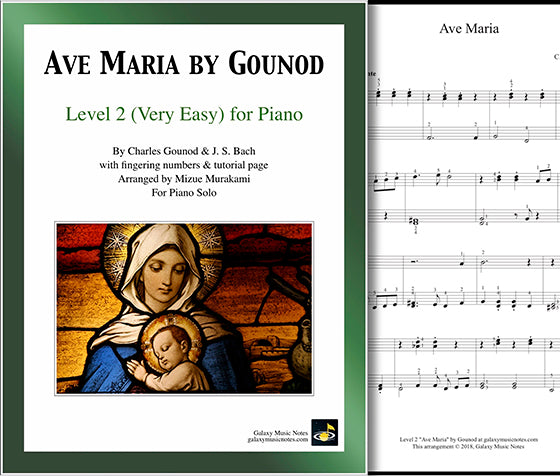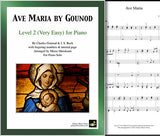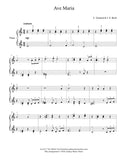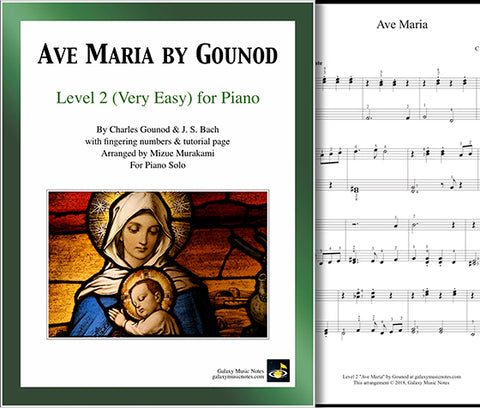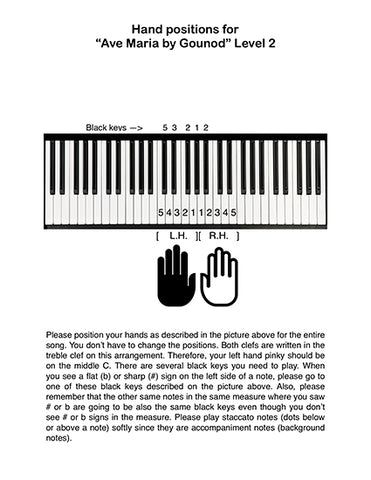Overview of this digital piano sheet music:
- "Ave Maria"
- Composers: Gounod and J. S. Bach
- Instrumentation: For piano solo
- Level 2: very easy level (See other levels of this music)
- Pages:
- 2 pages of music
- Tutorial page
- Cover sheet
- Key (for this arrangement): C major - Bach's prelude's original key
- Fingerings: all notes except the repeated notes
- Complete audio sample: Always free to listen to on our website. No vocal recording
- Downloading file: PDF
- Arranger and music editor: Mizue Murakami
- Publisher: Galaxy Music Notes
- Product code: GMNS00024
About "Ave Maria" by Gounod and Bach
This "Ave Maria" was composed by French composer, Charles Gounod (1818 - 1893) from the romantic era. Gounod created a melody on top of J. S. Bach's "Prelude in C Major" from The Well-Tempered Clavier composed by J. S. Bach (1685 – 1750) from the baroque era. It is commonly performed by piano and voice. To learn more about "Ave Maria" by Gounod and Bach, please visit our page, "The Story behind [Ave Maria] by Gounod and Bach."
Tips for playing Level 2 "Ave Maria" by Gounod and Bach
This particular arrangement on this page is for piano solo.You'll be playing both the simple accompaniment part and melody line (which was originally written for the voice). It is at a very easy level (level 2). You do not need to use a damper (sustain) pedal for this particular arrangement of "Ave Maria by Gounod" at Level 2. The fingering numbers are provided on all notes except some repeated notes. The key for this arrangement is written in the key of C Major which is the original key of Bach's original "Prelude in C Major" although the key that is commonly used to sing "Ave Maria" is in the key of F Major. The right and left hands play melody notes and harmonic notes by alternating very frequently. Many of the harmonic accompaniment-chord notes are marked with staccato signs (dots below or above the notes). Those notes are accompaniment notes. Therefore, please play them softer than melody notes since the accompaniment notes should be in the background.
After you download it, please locate the hand position on the tutorial page. You can stay in one hand position for the entire piece. Both clefs are written in the treble clef on this arrangement. Therefore, your left-hand pinky should be on the middle C. There are several black keys you need to play. When you see a flat (b) or sharp (#) sign on the left side of a note, please go to one of the black keys described on the picture on the tutorial page. Also, please remember that the other same notes in the same measure where you saw # or b are going to be also the same black key even though you don’t see # or b sign in the measure.
Download, Print (or see it on your tablet), and Practice!
This product is a digital download. After you purchase it, you will be downloading a PDF file. You should be able to download it to your desktop, laptop, smartphone or tablet if they are connected to the internet. You'll also receive a download link via email. You may download it later when it's convenient. After you download it, please print it out or see it on your tablet for your use. And most importantly, PRACTICE!
If you have a difficulty downloading a PDF file, you may need to upgrade or download Adobe Acrobat Reader. Please visit Adobe Acrobat Reader to download the newest Adobe Acrobat Reader.
You may also like:
- To learn more about both composers, Charles Gounod and J. S. Bach, please visit our pages, "About Charles Gounod," and "About J. S. Bach."
- To find more sheet music for pieces by J. S. Bach, please visit our collection page, "By J. S. Bach" at multi-levels.

